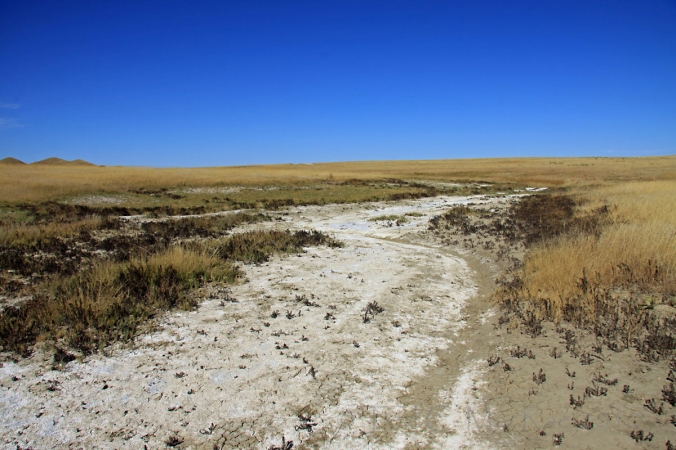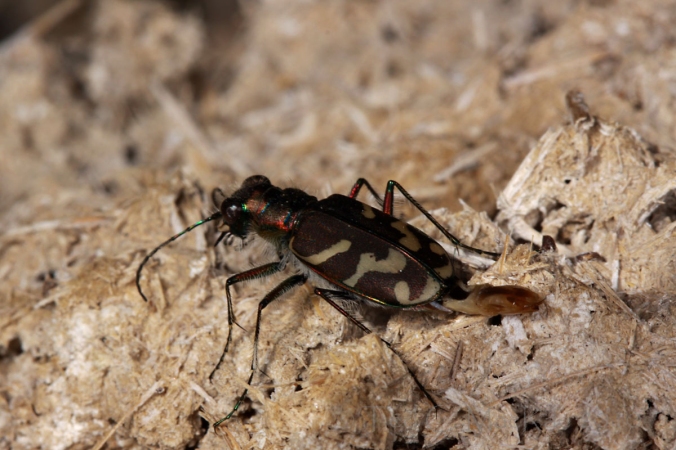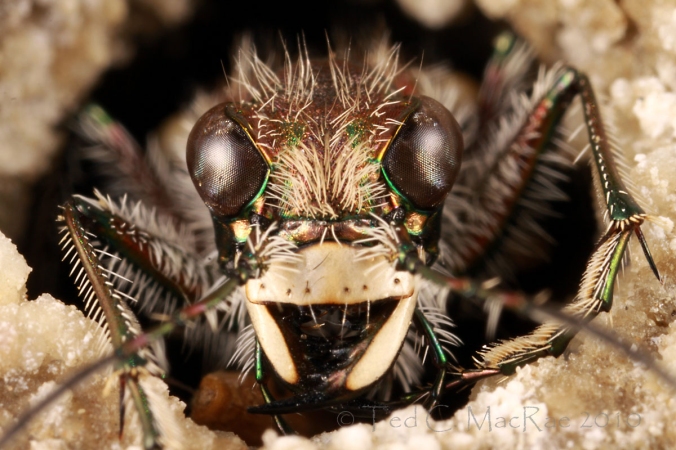At the northern edge of the Pine Ridge in northwestern Nebraska, the land drops precipitously from verdant High Plains to the eerie Badlands below. The sterile landscape of eroded slopes and irregularly shaped landforms is at once beautiful and harsh. Short grasses and silver sagebrush seem to be the only plants capable of living here, providing the meagerest of forage for the mule deer and pronghorn antelopes that dot the gently rolling hills. Dissecting these arid grasslands are a series of seasonally dry alkaline creeks that support a number of tiger beetle species. The most interesting of these is Cicindela fulgida fulgida (crimson saltflat tiger beetle), a beautifully colored little species that is restricted to wet, alkaline habitats. It was this species that I and colleagues Chris Brown and Matt Brust wanted to see when we stopped by one such creek after finishing up at the C. pulchra site in South Dakota (and still recovering from “pulchra-fever”).
I had been to this spot two years before and encountered a small number of C. fulgida along with much higher numbers of C. purpurea audubonii (Audubon’s tiger beetle) and C. tranquebarica kirbyi (Kirby’s tiger beetle). Our luck wasn’t any better this time, and in fact we would encounter only a single C. fulgida that day. This was Chris’ first opportunity to photograph this species, while I had already gotten some reasonably good field photos of the species during my 2009 visit to Salt Plains National Wildlife Refuge in northwestern Oklahoma. As he photographed the individual, I continuing scanning the bright, alkaline barrens. While I was not finding any C. fulgida, I was seeing a fair number of C. tranquebarica kirbyi, and it occurred to me that I still lacked good field photographs of this species. I began stalking different individuals, but in the heat of the day I found it impossible to get close enough to any of them to attempt any shots. It wasn’t until I encountered the individual shown above, apparently dragging something from its rear end, that I was able to close in for some shots. A closer look revealed the individual to be a male who had somehow gotten his genital capsule pulled out of his abdomen. Just the thought of how this might have happened makes me cringe. At any rate, the individual exhibits the relatively broader white maculations that distinguish this Great Plains/Rocky Mountain subspecies from the more eastern nominotypical subspecies.
As I continued scanning the soil, I noticed a number of larval burrows of what I took to be this species located up near the edge of the vegetated zone. One burrow in particular caught my attention – partly because of its slightly larger size and irregular outline, but also because there appeared to be something sitting within it. A closer look revealed an adult tiger beetle sitting just below the burrow entrance. Cicindela tranquebarica is a so-called “spring-fall” species that emerges initially in the fall as a sexually immature adult before digging back in for the winter and re-emerging in spring for mating and oviposition. I thus took this individual to be a newly emerged male that had not yet decided to leave its burrow and burst forth into a life of adulthood. The opportunity couldn’t be passed up – I took a few photos of him sitting there, then switched out the 100mm lens for the 65mm 1-5X lens. I had to get real close for this last shot, which caused him to retreat somewhat in his burrow. However, a knife thrust into the burrow below him, followed by careful twisting until it touched his rear, caused him to return to the burrow entrance and once again pause before embracing his new world.
Copyright © Ted C. MacRae 2010




Oh, wow! I love the in-the-burrow shots! He looks like he has been sprinkled with multicolored glitter. That’s too bad about the male with his junk fallen out his trunk – ouch.
Is your 65mm 1-5x lens a zoom lens? I am familiar with zoom lenses that are described by focal length, eg) 70-200mm. I haven’t learned macro jargon though.
I looked for tiger beetles while in Florida at Merritt Island NWR, but did not see any. Plenty of burrows, but I have no idea whose burrows they were.
Hi Amber – the 65mm is a fixed focal length lens with a minimum magnification of 1X and a maximum of 5X. It is a beast of a lens, expensive, and useful only for extreme closeup work. However, it is hard to beat for its intended use!
I have a post in prep on distinguishing different types of tiger beetle burrows that you might find useful.
Oh, that would be great. I split my time when I’m out between looking up (birds) and looking down (bugs, esp. Tiger Beetles). I see lots of holes in the ground, would be great to know more about Tiger Beetle burrows. Looking forward to it.
Wonderful shots of the beetle sitting in his burrow. Haven’t seen that before!
Thank, Kurt – first time I’ve ever seen it in the wild myself. I have observed it previously with a tiger beetle that I collected as a 3rd-instar larva and reared to adulthood in a terrarium, so I guess I had some idea what it might be when I first saw it.
Spectacular landscapes and creepy beetles, as usual, and one pre-prepped for pinning!
I’m still intrigued by the last posting on cursorial mantodeans (what Ware et al. use, but I think I’ll stick to mantids), but thinking about your tiger beetles, I guess they switch from ambush to cursorial predation at the pupa. That is quite behaviourally dexterous.
That is the beauty of holometabolism – the chance for a complete morphological and behavioral overhaul! I’m also struck by the similarity of the ground mantid (I still like mantodes!) predation strategy to that of adult tiger beetles.
The last shot is just amazing! What a great picture!
Thanks, Heath!
It looks a bit peeved in that last shot, like it’s about to launch itself at the lens!
The downward sloping inner eye angle gives it that appearance, but really it probably was peeved with me for prodding it back up to the burrow entrance. I have face-on shots of other species I’ve prodded so much with my finger that they cock their jaws half open in utter frustration!
Lovin’ the last shot, Ted. Nice field notes too 🙂
Thanks, Geek.
It’s already been said repeatedly, but I’ll say it again- last shot is phenomenal.
On another note, I love the landscape shot. It’s funny- it’s so easy to drive clear across the country without even seeing that kind of beautiful high plains/badlands.
I’m glad you mentioned the landscape shot, as I find myself inexplicably mesmerized by the Great Plains – for so many years I couldn’t see its stark beauty! Not an in-your-face type of spectacular beauty, but rather a subtle, haunting, isolated beauty.
I have some other nice scenery shots from the rest of the trip that I’ll show in future posts.
That last photo is spectacular! Though honestly I love the below-the-ground image just as much. This is a very handsome species. Your timing was impeccable with finding him in the burrow trying to decide whether or not it was time to come out.
Thank you, Jason. When I first saw it, I had to study it a bit to figure out what is was – at first I thought it might be a ground nesting bee, which I’ve seen sitting in the burrow in similar manner.
As for my timing – it’s just a matter of time in the field. The more of it you have, the more “impeccable” your timing becomes!
Ted, well done. Awesome photos and write up. The habitat photo is especially nice.
Thanks, Delbert. If I ever get around to writing “that book,” every tiger beetle photo will be accompanied by at least one habitat shot.
Great photos and text. I’ve found fresh holes, but never the beetle in the act. Very special!
Thanks, Margarethe!
Ted:
I have found many tiger beetles under boards, and cow chips at times, but only once saw an adult
in a burrow. This was a C. formosa formosa in Colorado on a sand blowout near Roggan (west of Ft. Morgan). That individual however, was in head first with the rear end sticking out.
I too appreciate your habitat photos. I have been lately trying to document habitat with photos for several of
our western species as I encounter them.
Yes, I commonly lift rocks on our glades during morning/evening hours to look for adults that have bedded down for the night or haven’t yet gotten up in the morning – never found one under a cow chip though!
The adult C. formosa you saw was likely in an overnight/midday burrow rather than emerging from its larval burrow – I’ve dug many a sand-loving species out of such burrows. The emergence burrows have quite a different look to them, and I only because I’ve reared a number of species in the lab did I realize fairly quickly what it was.
Habitat photos rock!